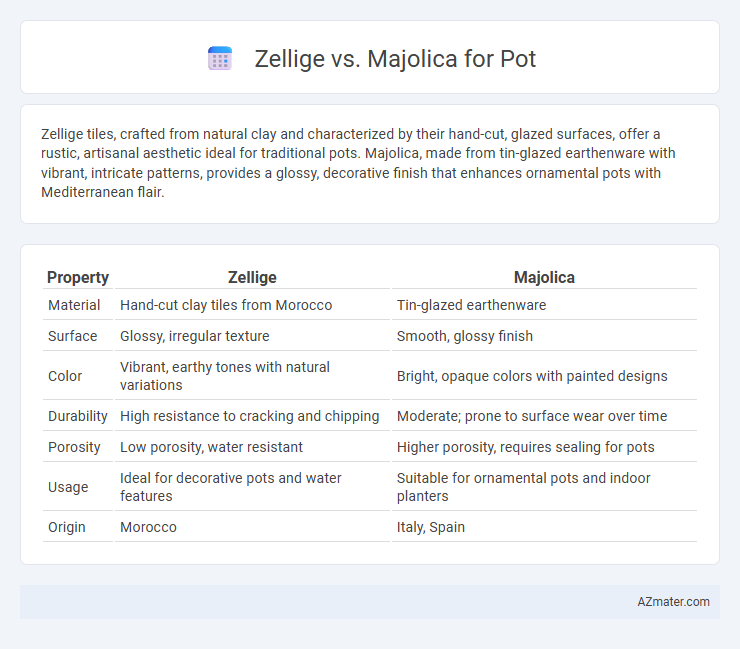Zellige tiles, crafted from natural clay and characterized by their hand-cut, glazed surfaces, offer a rustic, artisanal aesthetic ideal for traditional pots. Majolica, made from tin-glazed earthenware with vibrant, intricate patterns, provides a glossy, decorative finish that enhances ornamental pots with Mediterranean flair.
Table of Comparison
| Property | Zellige | Majolica |
|---|---|---|
| Material | Hand-cut clay tiles from Morocco | Tin-glazed earthenware |
| Surface | Glossy, irregular texture | Smooth, glossy finish |
| Color | Vibrant, earthy tones with natural variations | Bright, opaque colors with painted designs |
| Durability | High resistance to cracking and chipping | Moderate; prone to surface wear over time |
| Porosity | Low porosity, water resistant | Higher porosity, requires sealing for pots |
| Usage | Ideal for decorative pots and water features | Suitable for ornamental pots and indoor planters |
| Origin | Morocco | Italy, Spain |
Introduction to Zellige and Majolica
Zellige and Majolica are traditional ceramic tile techniques known for their vibrant colors and intricate patterns, often used in decorative pots and architectural elements. Zellige originates from Morocco and features hand-cut geometric tiles made from natural clay, creating a mosaic effect with a glossy finish. Majolica, an Italian Renaissance style, utilizes tin-glazed earthenware that allows for detailed, painted designs with a smooth, opaque surface ideal for ornate pottery.
Historical Origins of Zellige and Majolica
Zellige, originating in 10th-century Morocco, is a traditional mosaic tile technique using hand-cut terracotta pieces glazed in vibrant colors to form intricate geometric patterns, deeply rooted in Islamic art and architecture. Majolica, hailing from the Renaissance period in Italy, features tin-glazed pottery characterized by bright, opaque white surfaces decorated with colorful, hand-painted designs influenced by Mediterranean and Moorish styles. Both ceramics reflect rich cultural heritages, with Zellige emphasizing geometric precision and Majolica showcasing pictorial artistry, influencing pot designs through centuries of craftsmanship.
Materials and Techniques Used
Zellige tiles are handcrafted from natural clay and shaped using a traditional Moroccan technique involving cutting, glazing, and firing, resulting in intricate geometric patterns with a slightly uneven surface. Majolica pottery employs a tin-glazing method on earthenware clay, creating a smooth, opaque white surface that serves as a base for colorful, detailed painted designs before firing. The primary material difference lies in zellige's unglazed or partially glazed clay mosaic pieces versus majolica's fully glazed, painted ceramic body.
Color Palette and Design Patterns
Zellige tiles feature a rich, earthy color palette dominated by deep blues, greens, and terracotta tones, with intricate geometric patterns inspired by Moroccan craftsmanship, making them ideal for pots seeking a traditional and artisanal look. Majolica tiles offer a more vibrant and varied color spectrum, including bright yellows, blues, and whites, with floral and Mediterranean motifs that bring a lively and decorative aesthetic to pots. The choice between Zellige and Majolica depends on whether the desired design emphasizes geometric precision and subtle hues or bold, colorful, and floral patterns.
Durability and Suitability for Pots
Zellige tiles, crafted from natural clay and fired at high temperatures, offer superior durability and resistance to wear, making them highly suitable for outdoor and decorative pots exposed to weather changes. Majolica, characterized by its tin-glazed, colorful surface, provides an attractive finish but is more prone to chipping and cracking under heavy use or outdoor conditions. For pots that require long-lasting toughness and weather resistance, Zellige is the preferred choice, while Majolica suits ornamental indoor pots where aesthetic appeal is prioritized over rugged durability.
Aesthetic Appeal: Rustic vs. Refined
Zellige tiles showcase a rustic aesthetic with their handmade, irregular shapes and earthy tones, creating a warm, artisanal feel ideal for pots with a natural, traditional look. Majolica tiles offer a refined appearance, featuring smooth, glossy surfaces and intricate, colorful patterns that add a sophisticated and vibrant touch to pots. The choice between Zellige and Majolica hinges on whether a rustic charm or a polished elegance is desired for the pot's visual impact.
Maintenance and Cleaning Considerations
Zellige tiles, crafted from clay and featuring an irregular glazed surface, require gentle cleaning with mild, pH-neutral detergents to avoid damaging their intricate texture and color variations. Majolica pottery, known for its smooth, tin-glazed finish, is easier to maintain and can be cleaned with standard non-abrasive household cleaners without risking surface wear. Both materials benefit from regular dusting and prompt removal of stains to preserve their aesthetic appeal and longevity in pot applications.
Environmental Impact and Sustainability
Zellige tiles, handcrafted from natural clay and glazed with mineral-based pigments, offer a more sustainable choice for pots due to their biodegradable materials and traditional production methods with minimal chemical use. Majolica tiles, while also ceramic, often involve lead-based glazes and higher kiln temperatures, resulting in greater energy consumption and potential environmental toxins. Choosing Zellige supports eco-friendly practices by reducing chemical pollutants and promoting artisanal craftsmanship with a lower carbon footprint.
Cost Comparison and Availability
Zellige tiles typically cost more than Majolica tiles due to their handcrafted nature and complex production process, with prices ranging from $50 to $150 per square foot compared to Majolica's $20 to $60 per square foot. Availability of Zellige is more limited, often requiring special orders from artisanal workshops, whereas Majolica tiles are widely available through major tile suppliers and online retailers. Budget constraints and sourcing convenience often make Majolica a more accessible option for pot decoration projects.
Choosing the Right Style for Your Pot
Zellige tiles feature intricate geometric patterns and a glossy, textured finish ideal for creating a traditional Moroccan look on pots, while Majolica offers vibrant, hand-painted designs with a smooth, glazed surface perfect for Mediterranean-inspired decor. Selecting the right style depends on the desired aesthetic: choose Zellige for a rustic, artisanal vibe that emphasizes craftsmanship, or Majolica to achieve bold color contrasts and detailed floral motifs. Both styles use ceramic materials but differ in firing techniques and visual impact, making style choice crucial for aligning with your pot's intended ambiance and decor theme.

Infographic: Zellige vs Majolica for Pot
 azmater.com
azmater.com